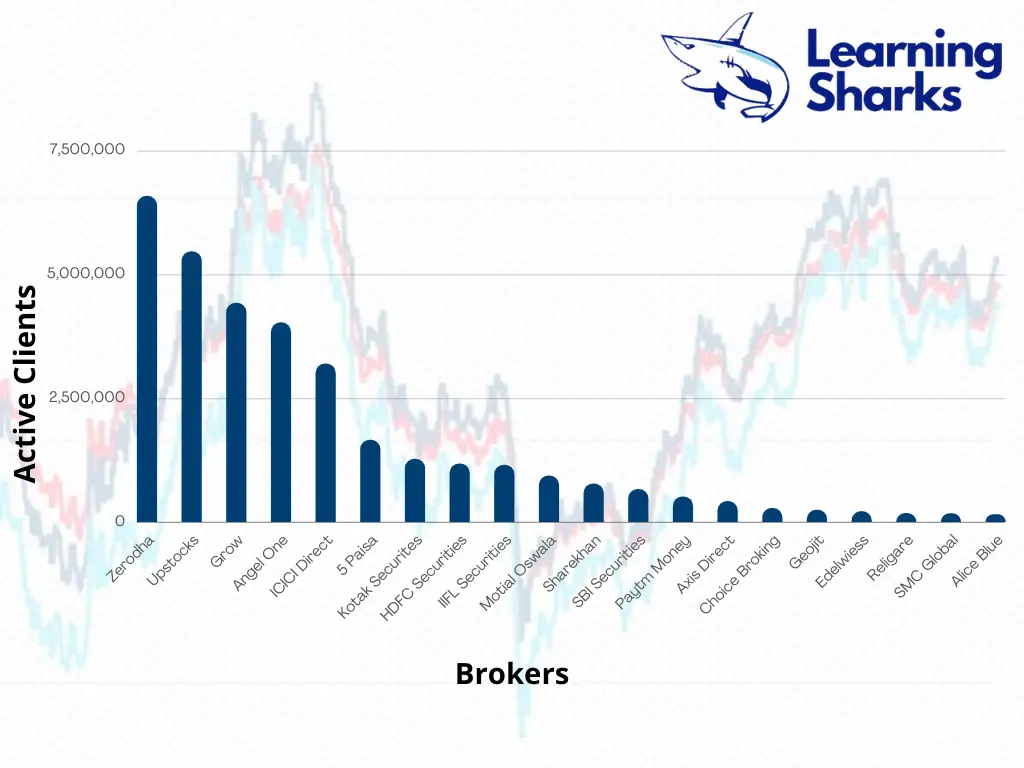There are two ways to learn about the stock market: trial and error and seeing what Successful Investors in India are doing.
If you are a rookie investor looking to make it to the top of the stock market, you must include both methods.
Understanding how the Top Investors in India invest and which stocks they select when investing can teach you a lot about the stock market as a whole and how and when to invest.
In this piece, we will cover the top 20 Share Market King in the country. We will go over their portfolio, investment strategy, and a variety of other aspects.
| Rank | Top Investors | Portfolio Value |
| 1 | Premji and Associates | 165,367 Cr. |
| 2 | Radhakrishnan Damani | 161,356 Cr. |
| 3 | Rakesh Jhunjhunwala | 29,237 Cr. |
| 4 | Mukul Agarwal | 2,413 Cr. |
| 5 | Sunil Singhania | 1,973 Cr. |
| 6 | Ashish Dhawan | 1,943 Cr. |
| 7 | Ashish Kacholia | 1,610 Cr. |
| 8 | Anil Kumar Goel | 1,495 Cr. |
| 9 | Mohnish Pabrai | 1,291 Cr. |
| 10 | Akash Bhansali | 2,984 Cr. |
We choose the Top 10 Investors in India by examining and comparing several criteria.
Indian stock market investors
We examined seven parameters for all of the investors and ranked them accordingly.
We assessed not only the figures but also their investment approach, diversification, short-term and long-term changes in the portfolio, investor popularity, and other factors.
Premji and Associates are ranked first in our ratings and rankings. Radhakrishnan Damani, Rakesh Jhunjhunwala, Mukul Agarwal, Sunil Singhania, and others are also on the list.
We have them ranked according to the total portfolio, but you can also find them ranked according to the particular factors below.
Premji and Associates – Top Investors in India
Premji and Associates are best known for Wipro, the country’s third-largest information technology company.
He is also the top investor in India despite only investing in four stocks, the largest of which being Wipro.
As of June 2022, his net worth exceeds Rs.165,367 crores. Azim Premji founded Wipro as a modest family firm in 1980, and since then, there has been no going back.
At the moment, his investment portfolio comprises primarily of three equities, the most valuable of which is Wipro Ltd., in which he has a stake worth Rs.165,130 crores.
Premji & Associates PortfolioHe also has 2,808,929 Tube Investments of India Ltd. shares worth Rs.631 crore.
Balrampur Chini Mills Ltd is another fresh addition to his business. He currently owns 2,523,641 shares worth Rs.97 crore.
Though he does not have a well-diversified portfolio like Stock Market King Rakesh Jhunjhunwala or RK Damani and mainly invests in technology firms, he now has the greatest net worth of any investor in the country.
Radhakrishnan Damani
Radhakrishnan Damani, often known as RK Damani, is known as “Mr. White & White” is one of India’s top traders because he constantly wears white.
One of the lesser-known facts about RK Damani is that he trained Rakesh Jhunjhunwala, India’s most recognised Share Market King.
Radhakrishnan Damani is the country’s richest trader, with a current portfolio worth Rs.161,356 crores as of June 2022.
Rakesh Jhunjhunwala
Mr. Rakesh Jhunjhunwala’s legacy will live on in Indian stock market history forever. He was born on July 5, 1960, and died on August 14, 2022. At the age of 62, he left us far too soon. But he will live on in our hearts for the rest of our lives.
Whether you buy stocks or not, you must have heard the name Rakesh Jhunjhunwala at least once in your life if you follow the news, particularly business and financial news.
He is known as “The Big Bull” of the Indian stock market and one of the top investors in India, not only because his net worth is enormous (Rs.29,237 crores as of June 2022), but also because of his social attitude.
Mr.Jhunjhunwala is well-known among investors, dealers, and finance experts both in India and overseas. He frequently appears in the media.
He is an inspiration to many investors across the country and beyond the world.
Mukul Agarwal
A new name has been added to the list of Top Share Market Investors in India recently and that is Mukul Agarwal. He is widely considered as India’s latest share market star.
Mr.Agarwal began trading and investing at the end of the 1990s and currently has a portfolio valued at Rs.2,413 crores as of June 2022.
He is a successful entrepreneur who runs a wealth management and financial advisory firm in Patna. He is also a TedX speaker and a motivational speaker.
Mukul Agarwal has an aggressive investment strategy in which he invests in equities in small sectors. He picks stocks that have the potential to generate enormous returns, invests in them, and then waits.
Sunil Singhania
Sunil Singhania ranks fifth among the Top 10 Investors in India, according to our results. Sunil Singhania’s portfolio is valued at Rs.1,973 crores as of June 2022.
Invest like Sunil Singhania – Top Indian Investors
He is a well-known figure in the financial world. He was the Chief Investment Officer of Reliance Mutual Fund.
He currently owns and operates his own Abakkus Fund house. Mr. Singhania is one of the country’s most well-known stock market investors.
He primarily invests in mid-cap and small-cap stocks, for which he has thorough expertise. Many people watch his every move and invest appropriately.
Ashish Dhawan
Ashish Dhawan is one of the Top 10 Big Bulls in the Indian Stock Market. He is well-known not just as an experienced investor, but also as a philanthropist and entrepreneur.
Invest like Ashish Dhawan, the Indian stock market’s big bull.
He founded Ashoka University and is the CEO of Central Square Foundation. His current portfolio value is Rs.1,943 crores, and he currently has 14 stocks in his portfolio.
His investment strategy involves investing in both large-cap and mid-cap firms. He has stocks from many industries to diversify his portfolio.
Ashish Kacholia
Ashish Kacholia is the seventh most successful investor in India’s stock market. His portfolio is valued at Rs.1,610 crores as of June 2022.
Invest like Ashish Kacholia – India’s top investor
He is well-known for his wagers on low-cost stocks with the potential for large returns.
One of the stocks he purchased in 2022 returned 140% in a year. The stock is located in Gateway Distriparks. Similarly, he has such investments in a variety of businesses.
His portfolio grew by 162.33% from Rs.585 crores in 2017 to Rs.1536 crores in 2022. In the near term, from June 2020 to June 2022, it increased by 268.27%.
Anil Kumar Goel
Anil Kumar Goel is India’s ninth-best investor. According to corporate filings, his portfolio was worth Rs.1,495 crores as of June 2022.
Invest in the stock market like Anil Kumar Goel.
He owns a portfolio of approximately 34 equities. He is well-known in the industrial world for his bets.
His portfolio worth increased by 124.78% from Rs.597 crores in June 2020 to Rs.1342 crores in June 2022. The portfolio has grown by 30.26% in the last five years.
Mohnish Pabrai
Mohnish Pabrai ranks ninth in terms of portfolio worth as a Big investor in India.
Invest like Mohnish Pabrai – India’s Top Traders
He is not only one of the Share Market’s Kings but also an entrepreneur who manages Pabrai Fund House and Dhandho Fund. He has a net worth of Rs.1,291 crores from just three stocks.
He is an Indian-American entrepreneur with extensive investment experience. Mr. Pabrai owns and operates his own fund companies as well as financial advising services.
He takes an extremely selective investment technique, investing in only a few stocks and staying invested for a long time.
While he does have other stocks in his portfolio, they are tiny stakes.
Akash Bhansali
Akash Bhansali is ranked 10th among the Top 10 Share Market Investors in India, with a current net worth of Rs.2,984 crores. He has an intriguing portfolio.
He has no IT or pharmaceutical stocks in his portfolio. Mr. Bhansali is a seasoned investor with years of expertise in the industry.
His portfolio worth has improved by 1121.86% in the last five years and 320.63% in the last two years.
IPL UPDATES: Join Now








































